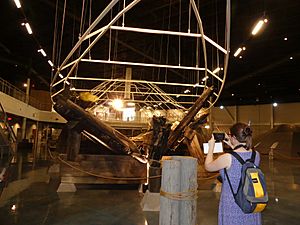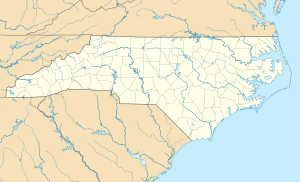CSS Neuse facts for kids

Remains of the lower hull of the Neuse
|
|
| History | |
|---|---|
| Namesake | Neuse River |
| Builder | Howard and Ellis, Kinston, North Carolina |
| Launched | November 1863 |
| Commissioned | April 1864 |
| Fate | Burned to prevent capture, March 1865 |
| General characteristics | |
| Type | Albemarle-class ironclad ram |
| Length | 152 ft (46 m) |
| Beam | 34 ft (10 m) |
| Draft | 9 ft (2.7 m) |
| Armament | 2 × 6.4 in (160 mm) Brooke rifles |
|
CSS Neuse (Ironclad Gunboat)
|
|
| Nearest city | Kinston, North Carolina |
| Area | 0.3 acres (0.12 ha) |
| Built | 1865 |
| Architect | Confederate Navy Dept.; Howard & Ellis |
| NRHP reference No. | 00000444 |
| Added to NRHP | June 11, 2001 |
The CSS Neuse was a powerful warship built during the American Civil War. It was an ironclad, meaning it was covered in thick metal armor. It also had a strong point at the front called a ram to smash into enemy ships. The Neuse belonged to the Confederate States Navy.
This ship was eventually sunk on purpose to stop it from being captured by the Union Army. Years later, in the 1960s, its lower part was found and brought up from the river. About 15,000 items from the ship were recovered, which is the most ever found from a Confederate ship! Today, you can see the remains of the Neuse and many of its artifacts at the CSS Neuse Interpretive Center State Historic Site in Kinston, North Carolina. This important ship is also listed on the National Register of Historic Places.
Contents
Building a Warship: The CSS Neuse
Building the Neuse started in October 1862. A company named Howard and Ellis signed a contract with the Confederate Navy. They built the ship on the banks of the Neuse River in North Carolina, which is how the ship got its name.
The Neuse was designed to be very similar to another ironclad ship, the CSS Albemarle. However, the Neuse had ten gun ports, which are openings for cannons, while the Albemarle had fewer. The ship was about 158 feet (48 m) long and 34 feet (10 m) wide. It was mostly built from local pine wood. For extra strength, it had 4 inches (100 mm) of oak wood behind its 4-inch-thick (100 mm) wrought iron armor.
Building the Neuse took a long time because of a shortage of materials. The biggest problem was getting enough iron plates for its armored top deck. Because of this, the Neuse was finished without armor on its deck. This made it one of the first Southern ironclads to have an unarmored deck. The Confederate States Army also got priority for using the limited railroad system to move war supplies, which made it even harder for the Navy to get iron.
Cannons and Ammunition
The Neuse was armed with two large 6.4-inch (160 mm) Brooke rifled cannons. These cannons were very heavy, weighing over 12,000 pounds (5,400 kg) each. They were placed in the middle of the ship's armored section, one at the front and one at the back.
These cannons could turn 180 degrees, allowing them to fire from either side of the ship. They could shoot from any of the five gun ports on each side, or both cannons could fire at the same time in a powerful "broadside." The Neuse used different types of ammunition. These included explosive shells, anti-personnel canister shot (like a giant shotgun blast), grape shot, and solid iron "bolts" designed to pierce enemy armored ships. Many examples of these different types of ammunition were found when the ship was recovered.
Life and End of the Ship
The Neuse was launched in November 1863, but it wasn't fully ready until April 1864. It was meant to patrol the rivers of North Carolina. Soon after it started service, the ship got stuck in the mud near Kinston. This happened because most of its crew were new and had been forced to join from the Confederate Army. It took almost a month to get the ship unstuck.
After this, the Neuse never left the Kinston area. It mostly served as a floating fort because there wasn't enough support from the Confederate Army on shore. In March 1865, Union forces were closing in on Kinston. To prevent the Neuse from being captured, its crew set it on fire. They also placed explosives in the front of the ship. The Neuse burned down to its waterline and then sank into the river mud. This stopped the Union Army, led by Major General John Schofield, from taking control of it.
After the war, people salvaged valuable metals from the sunken ship. They took the cannons, anchors, armor, propellers, and the steam engine. Whatever was left, including the ammunition, stayed hidden in the mud until the ship was found again almost a century later.
Finding the Ironclad Again
The lower part of the Neuse was discovered and raised in 1963. About 15,000 items from the ship were found and carefully recorded. The ship's hull was first put on display at the Governor Caswell Memorial in Kinston. Since 2013, the Neuse and its artifacts have been shown in a new, special building in downtown Kinston that controls the climate to protect them.
There are only four Civil War ironclad wrecks that have been recovered. These are the CSS Neuse, CSS Muscogee (also called CSS Jackson), USS Monitor, and USS Cairo. The Cairo is the only one that is still partly outside, under a cover, in the southern climate. Other ironclad wreck sites are known but have not been touched. The famous Confederate submarine H. L. Hunley, which sank a Union ship, was also recovered. It is now being restored and preserved in North Charleston, South Carolina.
Neuse II Replica
A full-size replica of the CSS Neuse, called Neuse II, was built thanks to a local businessman named Ted Sampley. Volunteers worked on Neuse II from 2002 to 2009. It is on display at a different site in Kinston and has a complete inside that shows all the ship's details. The Neuse is the only Confederate ironclad that has a full-size, historic replica on display.
Since 2002, the Neuse's sister ship, CSS Albemarle, has had a smaller replica. This replica is 3⁄8 scale and 63 feet (19 m) long. It is anchored near the Port O' Plymouth Museum in Plymouth, North Carolina. This replica can even sail on the river!
- Bright, Leslie S., Rowland, William H., and Bardon, James C. C.S.S. Neuse, A Question of Iron and Time. Division of Archives and History, North Carolina Department of Cultural Resources, Raleigh, NC. 1981. ISBN: 0-86526-187-3.
- Campbell, R. Thomas. Southern Thunder: Exploits of the Confederate States Navy, White Maine Publishing, 1996. ISBN: 1-57249-029-2.
- Campbell, R. Thomas. Southern Fire: Exploits of the Confederate States Navy, White Maine Publishing, 1997. ISBN: 1-57249-046-2.
- Campbell, R. Thomas. Fire and Thunder: Exploits of the Confederate States Navy, White Maine Publishing, 1997. ISBN: 1-57249-067-5.
- This article incorporates text from the public domain Dictionary of American Naval Fighting Ships. The entry can be found here.
Images for kids





